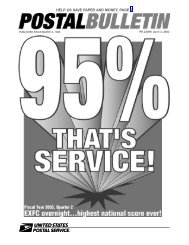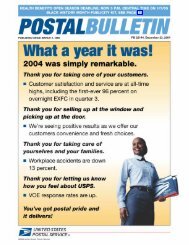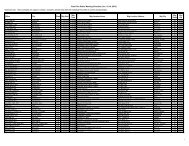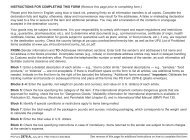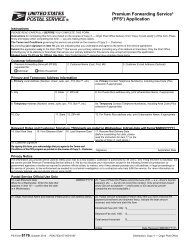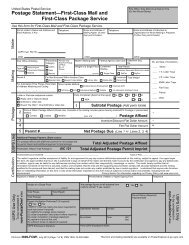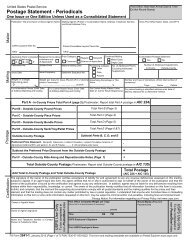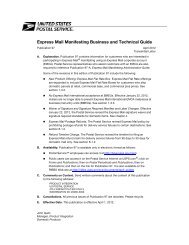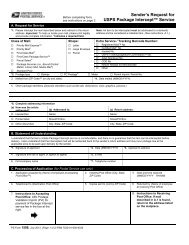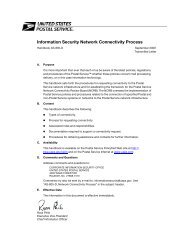Manifest Mailing System - USPS.com® - About
Manifest Mailing System - USPS.com® - About
Manifest Mailing System - USPS.com® - About
Create successful ePaper yourself
Turn your PDF publications into a flip-book with our unique Google optimized e-Paper software.
<strong>Manifest</strong> <strong>Mailing</strong> <strong>System</strong><br />
Publication 401-A<br />
August 2000
<strong>Manifest</strong> <strong>Mailing</strong> <strong>System</strong><br />
Understanding manifest mailing<br />
If you pay postage by permit imprint, you may manifest<br />
mail — that is, document postage for pieces of the<br />
same or different weights and rates combined in a<br />
single mailing.<br />
The <strong>Manifest</strong> <strong>Mailing</strong> <strong>System</strong> (MMS) can be used<br />
to pay for domestic and international postage,<br />
as well as fees for all special services, such as<br />
registered, insured, or COD mail. Using permit imprint<br />
indicia eliminates the need to affix postage (meters<br />
or stamps).<br />
In the MMS, each mailpiece is encoded with a unique<br />
identification number or keyline. The weight for each<br />
piece is entered into the computer either automatically<br />
by a scale connected to the computer or by an<br />
operator who weighs each piece or who uses<br />
predetermined weights. The computer calculates the<br />
postage and records it on a manifest corresponding to<br />
the identification number of that piece. The manifest<br />
can be on paper or in electronic form, such as a<br />
diskette or other accessible media.<br />
The Postal Service verifies the accuracy of the<br />
manifest by comparing random samples of the mailing.<br />
If the total postage or total weight of the pieces<br />
sampled differs from the manifest by 1.5 percent or<br />
less, the mailing is accepted with no postage<br />
adjustment. If the postage is understated by more than<br />
1.5 percent, the Postal Service will adjust the total<br />
postage for the mailing.<br />
Publication 401-A<br />
1
Choosing the MMS process<br />
that meets your needs<br />
MMS<br />
A manifesting system can use either itemized or batch<br />
processing:<br />
With itemized processing, the postage for piece-rate<br />
mail and the piece weight for pound-rate mail<br />
appears on the manifest for each piece.<br />
With batch processing, the total postage for a group<br />
of pieces appears on the manifest as a single line<br />
item.<br />
Benefits of itemized processing<br />
With itemized processing, you may assign a unique<br />
identification number before or after producing the<br />
piece. You print the ID number on each piece and list<br />
each one on the manifest, followed by other<br />
information related to calculating postage for the<br />
piece.<br />
Itemized processing is suitable for single-piece rate<br />
mailings and for mailings in which it is not easy to<br />
identify a specific batch of mail during postal sampling.<br />
You may list single-piece rate mail of different classes<br />
and/or processing categories on the same itemized<br />
manifest — this makes it easier to meet the minimum<br />
volume requirements for permit imprint mail.<br />
August 2 2000
<strong>Manifest</strong> <strong>Mailing</strong> <strong>System</strong><br />
Benefits of batch processing<br />
In batch processing, each piece has a unique<br />
identification number — shown in a keyline on the<br />
piece with other postage rate information — but these<br />
numbers are not listed individually on the manifest.<br />
You divide the mailing into batches of mailpieces with<br />
consecutive identification numbers, but list only the<br />
first and last pieces of the batch with the batch piece<br />
totals and the total postage charges for the entire<br />
batch.<br />
Batch processing produces a more abbreviated<br />
manifest than itemized processing. For this reason,<br />
batch processing is especially suitable for<br />
large-volume mailings of letter-size or flat-size<br />
pieces prepared in trays or sacks.<br />
Meeting volume requirements<br />
To receive discounted rates — such as presort<br />
rates — your mailings must meet certain minimum<br />
volume requirements. For example, the minimum<br />
volume of a Presorted First-Class mailing is 500<br />
pieces, and single-piece rate mailings must contain<br />
at least 200 pieces or must weigh 50 pounds. To meet<br />
minimum volume requirements, you may list<br />
single-piece rate mail of different classes and/or<br />
processing categories on one manifest.<br />
Publication 401-A<br />
3
Using special services<br />
with the MMS<br />
With the MMS, you may use all the special services<br />
of the Postal Service, including:<br />
Registered mail<br />
Collect On Delivery (COD) mail<br />
Insured mail<br />
Certified mail<br />
Return receipt for merchandise<br />
<strong>Manifest</strong>ing<br />
international mailings<br />
You may also use the MMS for mail addressed for<br />
delivery in foreign countries. To meet the minimum<br />
volume requirements for permit imprint mailings, you<br />
may combine single-piece rate international manifest<br />
mailings with different classes of single-piece rate<br />
domestic mail on the same manifest.<br />
Using the plant-verified<br />
drop shipment program<br />
MMS<br />
You may use the MMS to pay postage for<br />
plant-verified drop shipment (PVDS) mailings. The<br />
PVDS program allows you to receive more postage<br />
discounts for Standard Mail (A) and Standard Mail (B)<br />
mailings that you transport to destination postal<br />
facilities. You have the mail verified and you pay<br />
postage at your origin post office. Then you deposit<br />
the mail at the destination post office, and the mail is<br />
delivered to the addressees as usual.<br />
August 4 2000
<strong>Manifest</strong> <strong>Mailing</strong> <strong>System</strong><br />
Getting started with the MMS<br />
To participate in the MMS, you must develop a system<br />
that consistently generates mailings and<br />
documentation that meet postal standards.<br />
You can develop your own manifest mailing system<br />
in-house or acquire one from a vendor. The Postal<br />
Service’s <strong>Manifest</strong> Analysis & Certification (MAC)<br />
program has tested and certified MMS software<br />
produced by vendors. A list of MAC-certified vendors<br />
is available from your local post office, and also<br />
from the Internet at the following address:<br />
http://ribbs.usps.gov/files/vendors/macblist.pdf.<br />
Quality control is an important part of your MMS. Your<br />
quality control program must ensure:<br />
The integrity of the system.<br />
The accuracy of the documentation.<br />
The eligibility of the mailings prepared for the<br />
postage rates claimed.<br />
Getting approval for your MMS<br />
Getting the Postal Service’s approval for your MMS is<br />
not difficult. Here’s the basic process:<br />
Plan, develop, test, and install a computer system<br />
in-house or acquire a system from a vendor.<br />
Develop and administer effective quality control<br />
procedures that ensure the integrity of the system.<br />
Complete the application form (Exhibit 1 in<br />
Publication 401, Guide to <strong>Manifest</strong> <strong>Mailing</strong> <strong>System</strong>).<br />
Submit the application and all requested<br />
documentation.<br />
When the Postal Service completes a favorable review<br />
of your system, you will receive a 90-day authorization<br />
to begin manifest mailing. After a final favorable<br />
review, you will receive a 2-year authorization.<br />
Publication 401-A 5
Taking the first step<br />
MMS<br />
If you want to know more about setting up a manifest<br />
mailing system, contact your local Postal Service<br />
representative:<br />
Business mail entry employee<br />
Postmaster<br />
Account representative<br />
Or contact your MMS Quick Response Team (QRT),<br />
a team of manifest experts in your local area who can<br />
answer your manifesting questions. To get the<br />
telephone number for the QRT in your area, use<br />
Postal Explorer on the Internet at http://pe.usps.gov —<br />
first click on “Postal Links,” and then under Publication<br />
401, click on the hot link to the QRT list. The QRT<br />
telephone numbers for each area are listed by 3-digit<br />
ZIP Codes.<br />
On the Web<br />
You can access Publication 401, Guide to the <strong>Manifest</strong><br />
<strong>Mailing</strong> <strong>System</strong>, on the Web at the following address:<br />
www.usps.com/cpim/ftp/pubs/pub401.pdf<br />
It is important to read Publication 401 for all MMS<br />
details.<br />
August 6 2000
Saving time and money<br />
If you are faced with mailing large or small volumes<br />
of mail, there is a convenient way to save time and<br />
money — manifest mailing.<br />
How the <strong>Manifest</strong> <strong>Mailing</strong> <strong>System</strong> (MMS) works is<br />
described in detail in Publication 401, Guide to the<br />
<strong>Manifest</strong> <strong>Mailing</strong> <strong>System</strong>, which is available from<br />
any business mail entry office, postal business<br />
center, or Postal Service account representative.<br />
This brochure provides an overview of the benefits<br />
and process of setting up a manifest mailing system.



